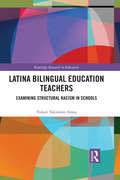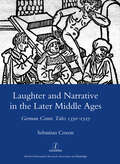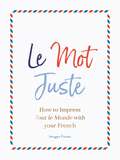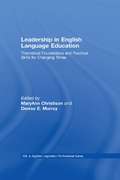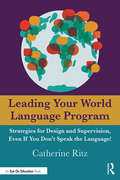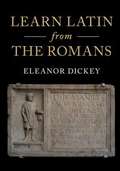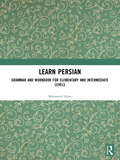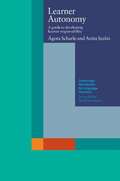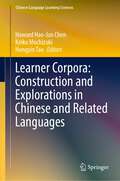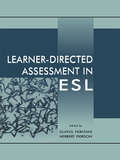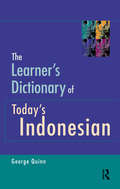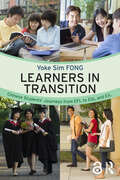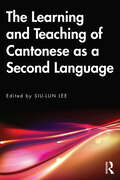- Table View
- List View
Latina Bilingual Education Teachers: Examining Structural Racism in Schools (Routledge Research in Education #22)
by Yukari Takimoto AmosUsing critical race theory and whiteness studies as theoretical frameworks, this book traces two Latina bilingual education teachers in three different professional phases: as paraprofessionals, teacher candidates, and certified teachers. Grounded in a longitudinal case study, this book sheds light on the effects of institutional racism when Latina/o educational professionals attempt inclusion in white dominant organizations, such as schools. Revealing and analyzing the structural racism present in schools and the obstacles it creates for professionals of color, the author exposes the racist practices that are hidden from view and offer practical solutions to combat them.
Latinum für Dummies (Für Dummies)
by Stefan MerkleGehören auch Sie zu den Studierenden, die an der Uni das Latinum nachholen müssen, weil es eine Voraussetzung für Ihren Abschluss ist, Sie aber in der Schule Latein nicht belegt hatten? Da gibt es sicher Angenehmeres. Aber wenn Sie schon im Lateinkurs sitzen, sollte das Lernen zumindest Spaß machen. Dieses Buch bereitet Sie auf die Klausur vor und hilft Ihnen, sie zu bestehen, auch wenn Sie zuvor keine Lateinkenntnisse hatten. Schritt für Schritt führt Stefan Merkle Sie in die lateinische Grammatik ein. Der Autor weiß, wo es hakt und welche grammatischen Formen besonders knifflig sind. Er vermittelt Übersetzungstechniken und weist Sie auf die häufigsten Fehlerquellen hin. Und nach den nachvollziehbaren Erklärungen heißt es dann üben, üben, üben - getreu dem Motto von null bis Caesar!
Laughter and Narrative in the Later Middle Ages: German Comic Tales C.1350-1525
by Sebastian CoxonIn contrast to the vernacular literary traditions of France, Italy and England, comic tales in verse flourished in late medieval Germany, providing bawdy entertainment for larger audiences of public recitals as well as for smaller numbers of individual readers. In a sustained close analysis Sebastian Coxon explores both the narrative design and fundamental thematic preoccupations of these short texts. A distinctively performative tradition of pre-modern narrative literature emerges which invited its recipients to think, learn and above all to laugh in a number of different ways.
Laughter and Narrative in the Later Middle Ages: German Comic Tales C.1350-1525
by Sebastian CoxonIn contrast to the vernacular literary traditions of France, Italy and England, comic tales in verse flourished in late medieval Germany, providing bawdy entertainment for larger audiences of public recitals as well as for smaller numbers of individual readers. In a sustained close analysis Sebastian Coxon explores both the narrative design and fundamental thematic preoccupations of these short texts. A distinctively performative tradition of pre-modern narrative literature emerges which invited its recipients to think, learn and above all to laugh in a number of different ways.
Le Mot Juste: How to Impress Tout le Monde with Your French
by Imogen Fortes'Charming, witty and cheerful, this is a delectable feast of the French language. Allez le Bleus!' Raymond BlancCelebrating the art of the French language with a charming collection of words and phrases to bring into everyday conversation. C’est parti!Have you ever wondered exactly what déjà vu is? Have you made a faux pas? Eaten an hors d’oeuvre? Voulez-vous an explanation of the above? Then voilà, here is a collection of les bons mots so you can start to learn that certain je ne sais quoi of the French language. Le Mot Juste contains 150 beautiful words and phrases that you’ll love to say every day.
Leadership in English Language Education: Theoretical Foundations and Practical Skills for Changing Times
by MaryAnn Christison Denise E. MurrayLeadership in English Language Education: Theoretical Foundations and Practical Skills for Changing Times presents both theoretical approaches to leadership and practical skills leaders in English language education need to be effective. Discussing practical skills in detail, and providing readers with the opportunity to acquire new skills and apply them in their own contexts, the text is organized around three themes: The roles and characteristics of leaders Skills for leading ELT leadership in practice Leadership theories and approaches from business and industry are applied to and conclusions are drawn for English language teaching in a variety of organizational contexts, including intensive English programs in English-speaking countries, TESOL departments in universities, ESL programs in community colleges, EFL departments in non-English speaking countries, adult education programs, and commercial ELT centers and schools around the world. This is an essential resource for all administrators, teachers, academics, and teacher candidates in English language education.
Leadership in English Language Education: Theoretical Foundations and Practical Skills for Changing Times
by MaryAnn Christison Denise E. MurrayLeadership in English Language Education: Theoretical Foundations and Practical Skills for Changing Times presents both theoretical approaches to leadership and practical skills leaders in English language education need to be effective. Discussing practical skills in detail, and providing readers with the opportunity to acquire new skills and apply them in their own contexts, the text is organized around three themes: The roles and characteristics of leaders Skills for leading ELT leadership in practice Leadership theories and approaches from business and industry are applied to and conclusions are drawn for English language teaching in a variety of organizational contexts, including intensive English programs in English-speaking countries, TESOL departments in universities, ESL programs in community colleges, EFL departments in non-English speaking countries, adult education programs, and commercial ELT centers and schools around the world. This is an essential resource for all administrators, teachers, academics, and teacher candidates in English language education.
Leading Your World Language Program: Strategies for Design and Supervision, Even If You Don’t Speak the Language!
by Catherine RitzAn essential resource for district, school, and program leaders who supervise, evaluate, or otherwise support World Language programs, this book provides clear, practical guidance on leading an exemplary K–12 World Language program. No matter whether you speak the language, the effective approaches in this book will equip you with the tools you need to implement and evaluate World Language curricula in your school. Catherine Ritz provides a clear and research-based framework for World Language instruction aligned to rigorous national and state standards, and addresses essential concepts and topics, including program and curriculum design, assessment and evaluation, and strategic planning. Whether you are a World Language department chair with years of experience, a school administrator with no background in language education, or a World Language teacher, you will find much to use in this book. It is chock-full of ready-to-use resources and tools, including: Templates for program and unit planning, observation protocols, and sample assessments World LAnguage program models for different age ranges, and a sample curriculum unit Additional resource lists and further reading recommendations.
Leading Your World Language Program: Strategies for Design and Supervision, Even If You Don’t Speak the Language!
by Catherine RitzAn essential resource for district, school, and program leaders who supervise, evaluate, or otherwise support World Language programs, this book provides clear, practical guidance on leading an exemplary K–12 World Language program. No matter whether you speak the language, the effective approaches in this book will equip you with the tools you need to implement and evaluate World Language curricula in your school. Catherine Ritz provides a clear and research-based framework for World Language instruction aligned to rigorous national and state standards, and addresses essential concepts and topics, including program and curriculum design, assessment and evaluation, and strategic planning. Whether you are a World Language department chair with years of experience, a school administrator with no background in language education, or a World Language teacher, you will find much to use in this book. It is chock-full of ready-to-use resources and tools, including: Templates for program and unit planning, observation protocols, and sample assessments World LAnguage program models for different age ranges, and a sample curriculum unit Additional resource lists and further reading recommendations.
Learn Latin From The Romans: A Complete Introductory Course Using Textbooks From The Roman Empire (PDF)
by Eleanor DickeyLearn Latin from the Romans is the only introductory Latin textbook to feature texts written by ancient Romans for Latin learners. These texts, the 'colloquia', consist of dialogues and narratives about daily life similar to those found in modern-language textbooks today, introducing learners to Roman culture as well as to Latin in an engaging, accessible, and enjoyable way. Students and instructors will find everything they need in one complete volume, including clear explanations of grammatical concepts and how Latin works, both British and American orders for all noun and adjective paradigms, 5,000 easy practice sentences, and over 150 longer passages (from the colloquia and a diverse range of other sources including inscriptions, graffiti, and Christian texts as well as Catullus, Cicero, and Virgil). Written by a leading Latin linguist with decades of language teaching experience, this textbook is suitable for introductory Latin courses worldwide.
Learn Persian: Grammar and Workbook for Elementary and Intermediate Levels
by Mahmood AlamLearn Persian has a step-by-step organized and structured framework of modern Persian words; grammar, short syntactical phrases and idiomatic expressions. Persian has a lot of common words and sounds from Arabic and Urdu; this work highlights vowels and consonants that are covered in the formation of words and sounds with apt precision. The special feature of this book is its simplicity, yet meaningful and comprehensiveness for the study of the language. This should be a good source book for new learners, as well as for those who want to explore the harmony and flair of Persian. It would undoubtedly open doors to a Persian heritage as much as it slowly trains the eager learner in spoken Persian as well. Learn Persian will interest both learners and experts, and an excellent experience of coming across Persian as an interesting living language.
Learn Persian: Grammar and Workbook for Elementary and Intermediate Levels
by Mahmood AlamLearn Persian has a step-by-step organized and structured framework of modern Persian words; grammar, short syntactical phrases and idiomatic expressions. Persian has a lot of common words and sounds from Arabic and Urdu; this work highlights vowels and consonants that are covered in the formation of words and sounds with apt precision. The special feature of this book is its simplicity, yet meaningful and comprehensiveness for the study of the language. This should be a good source book for new learners, as well as for those who want to explore the harmony and flair of Persian. It would undoubtedly open doors to a Persian heritage as much as it slowly trains the eager learner in spoken Persian as well. Learn Persian will interest both learners and experts, and an excellent experience of coming across Persian as an interesting living language.
Learn to Use Chinese Aspect Particles
by Jian Kang LoarAspect in Mandarin Chinese plays an important role in interpreting the temporal information of a sentence. It is an important verbal category, which is concerned with the speaker’s viewpoint or perspective on a situation: whether the situation is presented as complete (perfective aspect) or as ongoing (imperfective aspect), etc. Learning to understand the aspect particles or markers, and use them correctly, has always been one of the most difficult tasks for learners of Chinese. Learn to Use Chinese Aspect Particles is a pedagogical guide designed to equip teachers with necessary aspectual theoretical knowledge, and is aimed at in-service or trainee teachers, and intermediate or advanced students to reinforce teaching and learning. Challenging exercises are designed and explanations for the correct use of an aspect particle are given, thus making the book more useable and convenient to teachers and enhancing the practical reference value of the book.
Learn to Use Chinese Aspect Particles
by Jian Kang LoarAspect in Mandarin Chinese plays an important role in interpreting the temporal information of a sentence. It is an important verbal category, which is concerned with the speaker’s viewpoint or perspective on a situation: whether the situation is presented as complete (perfective aspect) or as ongoing (imperfective aspect), etc. Learning to understand the aspect particles or markers, and use them correctly, has always been one of the most difficult tasks for learners of Chinese. Learn to Use Chinese Aspect Particles is a pedagogical guide designed to equip teachers with necessary aspectual theoretical knowledge, and is aimed at in-service or trainee teachers, and intermediate or advanced students to reinforce teaching and learning. Challenging exercises are designed and explanations for the correct use of an aspect particle are given, thus making the book more useable and convenient to teachers and enhancing the practical reference value of the book.
Learner Autonomy: A Guide to Developing Learner Responsibility (PDF) (Cambridge Handbooks For Language Teachers Ser.)
by Agota ScharleLearner Autonomy offers practical guidance on helping learners realise that their contribution to the teaching-learning process is crucial. It also encourages them to take an active role in their own learning. Rather than advocating radical changes in Classroom Management, it focuses on the gradual process of changing learner attitudes. The activities are designed to develop a comprehensive range of skills and attitudes including motivation, learning strategies, self-monitoring and co-operation. The activities can be easily integrated into the regular curriculum as almost all serve some linguistic purpose in addition to learner development.
Learner Corpora: Construction and Explorations in Chinese and Related Languages (Chinese Language Learning Sciences)
by Howard Hao-Jan Chen Keiko Mochizuki Hongyin TaoThis edited book reflects the state of the art in learner corpus and related approaches to Chinese as a second language (CSL). CSL as a field has flourished in the past few decades due to the increasingly important role of the Chinese language at the world stage, yet studies of Chinese as a second language based on learner corpora have been less well developed due to the limited availability of data and lack of theoretical insights. This book represents the latest research in this area by 1) assembling a large group of active researchers from multiple international research communities (USA, China, Hong Kong, Macau, Japan, Taiwan, and France); 2) discussing the latest resources and technologies in Chinese and other Asian languages learner corpora and corpus building; 3) basing Chinese as a second language studies on data from learners of Chinese with a wide range of first language backgrounds (English, Japanese, Korean, French, among others); and 4) integrating corpus methods with a wide range of related methods in allied fields—language acquisition, usage-based linguistics, psycholinguistics, and neurolinguistics. This comprehensive collection is indispensable for anyone who is interested in corpus approaches to CSL and Chinese applied language studies in general.
Learner-directed Assessment in Esl
by Glayol V. Ekbatani Herbert D. PiersonThis text integrates the theory and practice of learner-based assessment. Written in response to two recent movements in language teaching--learner-centered teaching and a renewed interest in authenticity in language testing--it examines the relationship between the language learner and language assessment processes, and promotes approaches to assessment that involve the learner in the testing process. Particular attention is given to issues of reliability and validity. Grounded in current pedagogical applications of authentic assessment measures, this volume is intended for and eminently accessible to classroom teachers and program directors looking for ways to include their students in the evaluation process, graduate students, and professional language testers seeking authenticity in assessment and desiring to create more interactive evaluation tools.
Learner-directed Assessment in Esl
by Glayol V. Ekbatani Herbert D. PiersonThis text integrates the theory and practice of learner-based assessment. Written in response to two recent movements in language teaching--learner-centered teaching and a renewed interest in authenticity in language testing--it examines the relationship between the language learner and language assessment processes, and promotes approaches to assessment that involve the learner in the testing process. Particular attention is given to issues of reliability and validity. Grounded in current pedagogical applications of authentic assessment measures, this volume is intended for and eminently accessible to classroom teachers and program directors looking for ways to include their students in the evaluation process, graduate students, and professional language testers seeking authenticity in assessment and desiring to create more interactive evaluation tools.
The Learner's Dictionary of Today's Indonesian
by George QuinnWhat are the 24 words for 'you' in Indonesian? Why does Indonesian have four words for 'rice but no exact equivalent of 'farm'? How do you say 'Bang!' 'Ouch!' and 'Eh?'. What is the difference between dong and doang in colloquial Indonesian? How did the name of the Hindu god Indra give us the modern Indonesian word for motor vehicle?Whether you are a beginner or an advanced student of Indonesian, The Learner's Dictionary of Today's Indonesian is an essential tool to help you gain an authentic, up-to-date, and active command of the language. It provides a wholly new, very detailed snapshot of the core vocabulary of Indonesian.Among its features are:* thousand of illustrative sentences* an easy pronunciation guide* extensive cross-referencing* helpful tips on usage* topic lists which group the dictionary's words according to 42 'common usage' areas, including time, colours, daily activities, the home, sport, occupations, mass media, religion and business.A unique feature of the dictionary is the dozens of boxes giving invaluable information on everyday usage, word origins and nuances of meaning.Rich in information on the cultural context in which words are used, it includes notes on the difficulties learners experience arising from differences in culture and history between English-speakers and Indonesian-speakers. The Learner's Dictionary of Today's Indonesian is the first comprehensive dictionary designed specifically to help you gain a practical command of the national language of one of the world's most populous nations.
Learners in Transition: Chinese Students’ Journeys from EFL to ESL and EIL
by Yoke Sim FongAs the number of Chinese students learning English increases worldwide, the need for teachers to understand the characteristics and challenges facing this group of learners grows. This is particularly true for those students moving from an English as a Foreign Language context to an English as a Second Language/International Language one where they experience academic, linguistic and sociocultural transitions. Drawing on over 20 years’ experience teaching English courses to Chinese learners, the author aims to highlight key findings to aid understanding, improve teachers’ practice and offer pedagogical recommendations. Using students’ voices, the book covers: how the traditional Chinese culture of learning plays a role; how new learning contexts provide opportunities and empowerment; how learners’ beliefs and strategies are interconnected; how their motivation and identity underscore the power of real and imagined communities, and finally, that affect matters, showing how learners are propelled by the trajectory of their emotions. The book cites from the rich data collected over a five-year period to authenticate the findings and recommendations but also to give voice to this group of learners to challenge the stereotype of the passive "Chinese learner". The essential insights contained within are useful for pre- and in-service teachers of English and researchers interested in language education around the world.
Learners in Transition: Chinese Students’ Journeys from EFL to ESL and EIL
by Yoke Sim FongAs the number of Chinese students learning English increases worldwide, the need for teachers to understand the characteristics and challenges facing this group of learners grows. This is particularly true for those students moving from an English as a Foreign Language context to an English as a Second Language/International Language one where they experience academic, linguistic and sociocultural transitions. Drawing on over 20 years’ experience teaching English courses to Chinese learners, the author aims to highlight key findings to aid understanding, improve teachers’ practice and offer pedagogical recommendations. Using students’ voices, the book covers: how the traditional Chinese culture of learning plays a role; how new learning contexts provide opportunities and empowerment; how learners’ beliefs and strategies are interconnected; how their motivation and identity underscore the power of real and imagined communities, and finally, that affect matters, showing how learners are propelled by the trajectory of their emotions. The book cites from the rich data collected over a five-year period to authenticate the findings and recommendations but also to give voice to this group of learners to challenge the stereotype of the passive "Chinese learner". The essential insights contained within are useful for pre- and in-service teachers of English and researchers interested in language education around the world.
Learning and Teaching Chinese as a First Language: International Perspectives (The Routledge Series on Chinese Language Education)
by Lee, John Chi-Kin Chung Mou Si Lam, Sin Manw SophiaIn this book, the authors embark on a critical investigation of the complex field of Chinese language education, with a particular focus on exploring new trends and teaching and learning. They delve into the intricacies of language, education and its effectiveness in teaching Chinese as a first language.The book has three objectives: establishing a field of study in Chinese language learning and teaching, providing critical discussion and progressive insights on language education, and offering relevant pedagogical perspectives of learning and teaching Chinese as L1 and L2. The chapters investigate learning and teaching of Chinese in different aspects, including four skills, culture, literature, technology-assisted learning, and learners’ identity. By focusing on the teaching practices of Chinese at different levels, it sheds light on teaching Chinese as a first language. Theoretically, it broadens the linguistic and geographical reach of previous works on language education that mainly examine English as a lingua franca or children’s first language acquisition. Drawing upon theories in language learning, the book demonstrates the applicability of language theories in the first language and Chinese as a non-alphabetic language and examines the impact and effectiveness of some theories in Chinese learning and teaching.Academic researchers, teacher educators, teachers and students interested in Chinese language and education will find this a highly relevant text for its focus on curriculum, pedagogy and assessment of teaching Chinese as a first language.
Learning and Teaching Chinese as a First Language: International Perspectives (The Routledge Series on Chinese Language Education)
In this book, the authors embark on a critical investigation of the complex field of Chinese language education, with a particular focus on exploring new trends and teaching and learning. They delve into the intricacies of language, education and its effectiveness in teaching Chinese as a first language.The book has three objectives: establishing a field of study in Chinese language learning and teaching, providing critical discussion and progressive insights on language education, and offering relevant pedagogical perspectives of learning and teaching Chinese as L1 and L2. The chapters investigate learning and teaching of Chinese in different aspects, including four skills, culture, literature, technology-assisted learning, and learners’ identity. By focusing on the teaching practices of Chinese at different levels, it sheds light on teaching Chinese as a first language. Theoretically, it broadens the linguistic and geographical reach of previous works on language education that mainly examine English as a lingua franca or children’s first language acquisition. Drawing upon theories in language learning, the book demonstrates the applicability of language theories in the first language and Chinese as a non-alphabetic language and examines the impact and effectiveness of some theories in Chinese learning and teaching.Academic researchers, teacher educators, teachers and students interested in Chinese language and education will find this a highly relevant text for its focus on curriculum, pedagogy and assessment of teaching Chinese as a first language.
The Learning and Teaching of Cantonese as a Second Language
by Siu-Lun LeeThe Learning and Teaching of Cantonese as a Second Language brings together contributions on such issues as Cantonese textbooks, linguistic description, literacy and tone acquisition, supplemented by case studies from the Netherlands and Japan. The learning and teaching of Cantonese as a second language is a subject of considerable interest in the international academic community, and the first international symposium on teaching Cantonese as a second language, held at the Chinese University of Hong Kong in October 2019, brought together leading researchers in this field. This conference provided the inspiration for the current volume, The Learning and Teaching of Cantonese as a Second Language. In the Hong Kong context, historically, the term ‘Cantonese’ refers to the language varieties of immigrants who came to the territory from various areas in Guangdong province, including Macau, Panyu, Taishan, Xinhui and Zhongshan. From the late nineteenth century onwards, their speech coalesced into the contemporary variety of Cantonese used in Hong Kong today. The term ‘Cantonese’ is also used to refer to the entire Yue subgroup of Chinese, which includes varieties of Cantonese spoken in southern China, Hong Kong, Macau, Malaysia, Singapore and among overseas Chinese in Australia, Europe and North America. In all, it is estimated that there are about 70 million Cantonese speakers in the world. This volume is of direct relevance to educators, language teachers, linguists and all those concerned with the learning of Cantonese as a second language.
The Learning and Teaching of Cantonese as a Second Language
The Learning and Teaching of Cantonese as a Second Language brings together contributions on such issues as Cantonese textbooks, linguistic description, literacy and tone acquisition, supplemented by case studies from the Netherlands and Japan. The learning and teaching of Cantonese as a second language is a subject of considerable interest in the international academic community, and the first international symposium on teaching Cantonese as a second language, held at the Chinese University of Hong Kong in October 2019, brought together leading researchers in this field. This conference provided the inspiration for the current volume, The Learning and Teaching of Cantonese as a Second Language. In the Hong Kong context, historically, the term ‘Cantonese’ refers to the language varieties of immigrants who came to the territory from various areas in Guangdong province, including Macau, Panyu, Taishan, Xinhui and Zhongshan. From the late nineteenth century onwards, their speech coalesced into the contemporary variety of Cantonese used in Hong Kong today. The term ‘Cantonese’ is also used to refer to the entire Yue subgroup of Chinese, which includes varieties of Cantonese spoken in southern China, Hong Kong, Macau, Malaysia, Singapore and among overseas Chinese in Australia, Europe and North America. In all, it is estimated that there are about 70 million Cantonese speakers in the world. This volume is of direct relevance to educators, language teachers, linguists and all those concerned with the learning of Cantonese as a second language.
